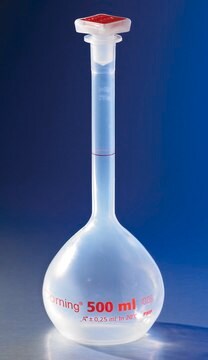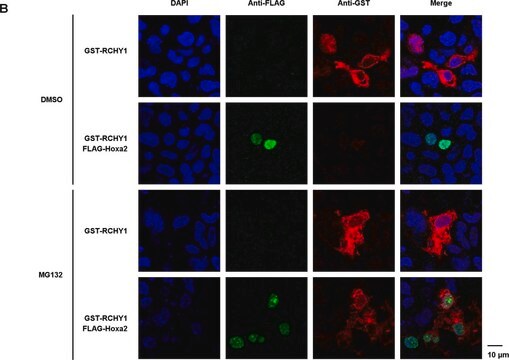일반 설명
We are committed to bringing you greener alternative products, which adhere to one or more of The 12 Principles of Green Chemistry.This antibody is Preservative-free, produced without the harm or sacrifice of animals and exceptionally stable to allow for ambient shipping and storage if needed and thus aligns with "Waste Prevention", "Designing Safer Chemicals" and "Design for Energy Efficiency".
Click here for more information.
ZooMAb® antibodies represent an entirely new generation of recombinant monoclonal antibodies.Each ZooMAb® antibody is manufactured using our proprietary recombinant expression system, purified to homogeneity, and precisely dispensed to produce robust and highly reproducible lot-to-lot consistency. Only top-performing clones are released for use by researchers. Each antibody is validated for high specificity and affinity across multiple applications, including its most commonly used application. ZooMAb® antibodies are reliably available and ready to ship when you need them.
특이성
Clone 2G2 is a ZooMAb® rabbit recombinant monoclonal antibody that specifically detects IKKa/β phosphorylated on serine 176 and 180.
면역원
KLH-conjugated linear peptide corresponding to 13 amino acids surrounding phosphoserine 176 and 180 from human IKKa.
애플리케이션
Quality Control Testing
Evaluated by Western Blotting in a construct containing GST-tagged recombinant IKK /β protein fragment phosphorylated on Ser176/180.
Western Blotting Analysis: A 1:1,000 dilution of this antibody detected a construct containing GST-tagged recombinant IKK /β protein fragment phosphorylated on Ser176/180, but did not detect in non-phosphorylated construct. (Phospho- IKK /β construct: Courtesy of Dr. Jesse Rinehart, Yale University, School of Medicine).
Tested applications
Immunohistochemistry (Paraffin) Analysis: A 1:100 dilution from a representative lot detected phospho-IKK /β-Ser176/180 in human colon cancer tissue sections.
Affinity Binding Assay: A representative lot of this antibody bound Phospho-IKK /β- Ser176/180 peptide with a KD of 3.2 x 10-7 in an affinity binding assay.
Peptide Inhibition Assay: Target band detection in a construct containing GST-tagged recombinant IKKa protein fragment phosphorylated on Ser 176/180 was prevented by pre-blocking of a representative lot with the immunogen phosphopeptide, but not the corresponding non-phosphopeptide.
Note: Actual optimal working dilutions must be determined by end user as specimens, and experimental conditions may vary with the end user
표적 설명
Inhibitor of nuclear factor kappa-B kinase subunit alpha (UniProt: O15111; also known as EC:2.7.11.10, I-kappa-B kinase alpha, IKK-A, IKK-alpha, IkBKA, IkappaB kinase, Conserved helix-loop-helix ubiquitous kinase, I-kappa-B kinase 1, IKK1, Nuclear factor NF-kB inhibitor kinase alpha, NFKBIKA, Transcription factor 16, TCF-16) is encoded by the CHUK (also known as IKKA, TCF16) gene (Gene ID:1147) in human. The activation of NF-kB by extracellular inducers depends on the phosphorylation and subsequent degradation of IkkB proteins. Activation of NF-kB is achieved through the action of a family of kB kinases (IKK). IKK contain two catalytic subunits (IKKa and IKKβ) and a regulatory/adapter protein IKK (NEMO). IKK and IKKβ play an essential role in NF-kB signal transduction that is activated by multiple stimuli. Their protein kinase domains are localized in amino acids 15-302 (IKK ) and 15-300 (IKKβ). Their leucine-zipper, localized in amino acids 455-476 (for IKKa) and 458-479 (for IKKβ), is important to allow for their homo- and hetero-dimerization. IKKa/IKKβ act as part of the canonical IKK complex in the conventional pathway of NF-kB activation and phosphorylate serine residues on IkBa and IkBβ. Although IKK and IKKβ share about 50% sequence homology, they can interchangeably phosphorylate Ser32/36 of IkBa and Ser 19/23 of IkBβ. These phosphorylation events lead to immediate polyubiquitination and degradation of IkB proteins and allow NF-kB to translocate to the nucleus where it activates the transcription of hundreds of genes involved in immune response, growth control, and protection against apoptosis. This ZooMAbZooMAb® recombinant monoclonal antibody, generated by our propriety technology, offers significantly enhanced specificity, affinity, reproducibility, and stability over conventional monoclonals. (Ref.: Solt, LA., and May, MJ. (2008). Immunol. Res. 42(1-3); 3-18; Regnier, CH., et al. (1997). Cell. 90(2); 373-383).
물리적 형태
Purified recombinant rabbit monoclonal antibody IgG, lyophilized in PBS, 5% Trehalose, normal appearance a coarse or translucent resin. The PBS/trehalose components in the ZooMAb formulation can have the appearance of a semi-solid (bead like gel) after lyophilization. This is a normal phenomenon. Please follow the recommended reconstitution procedure in the data sheet to dissolve the semi-solid, bead-like, gel-appearing material. The resulting antibody solution is completely stable and functional as proven by full functional testing. Contains no biocide or preservatives, such as azide, or any animal by-products. Larger pack sizes provided as multiples of 25 μL.
저장 및 안정성
Recommend storage of lyophilized product at 2-8°C; Before reconstitution, micro-centrifuge vials briefly to spin down material to bottom of the vial; Reconstitute each vial by adding 25 μL of filtered lab grade water or PBS; Reconstituted antibodies can be stored at 2-8°C, or -20°C for long term storage. Avoid repeated freeze-thaws.
법적 정보
ZooMAb is a registered trademark of Merck KGaA, Darmstadt, Germany
면책조항
Unless otherwise stated in our catalog or other company documentation accompanying the product(s), our products are intended for research use only and are not to be used for any other purpose, which includes but is not limited to, unauthorized commercial uses, in vitro diagnostic uses, ex vivo or in vivo therapeutic uses or any type of consumption or application to humans or animals.










